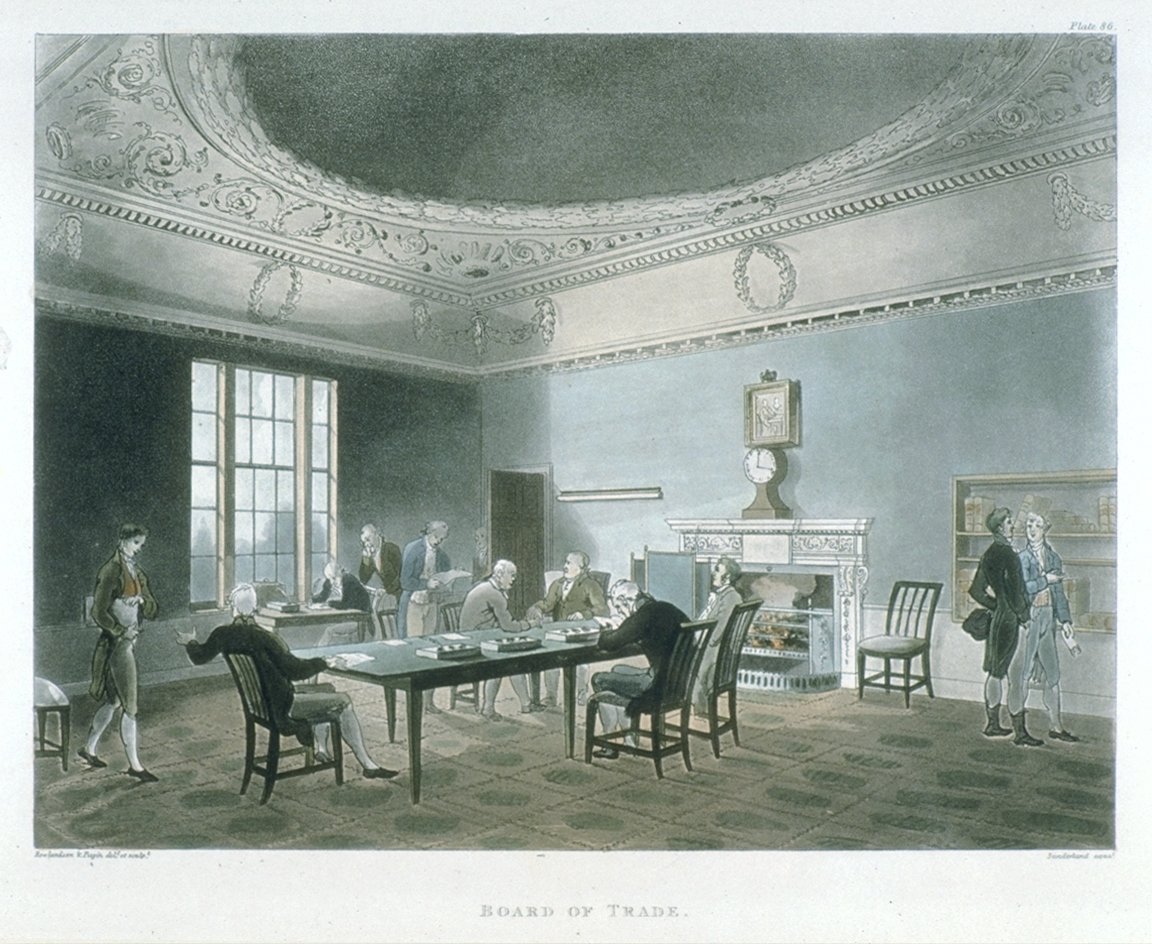Board of Trade
Thomas Rowlandson (1756 - 1827)
Auguste Charles Pugin (1762 - 1832)
Thomas Sunderland (1744 - 1828)
Colour aquatint
published 1 October 1809
-
About the work
- Location
-
Country: UK
City: London
Place: Downing Street
The clerks and officers of the Board of Trade are hard at work in an office situated in the northern part of the Treasury building on the corner of Downing Street and Whitehall. The room was part of the original Palace of Westminster which escaped the fire. It later formed part of the home of James and Anne, the Duke and Duchess of Monmouth and Buccleuch, and may have been their bedchamber. Although not visible in this image, the initials of the Duke and Duchess, ‘JAMB’, were included in the richly ornamented ceiling, below a ducal coronet. The Board of Trade building was later remodelled by the architect Sir John Soane and then by Sir Charles Barry. The elaborate ceiling of the room no longer survives and it is doubtful whether the room itself has survived the numerous alterations to the building since this work was made.
This engraving is taken from ‘The Microcosm of London’, published in three volumes by Rudolf Ackermann between 1808 and 1811. The text was written by the artist and writer William Pyne and the volumes were illustrated with 104 hand-coloured aquatint plates after works by Pyne, Thomas Rowlandson and Augustus Charles Pugin.
-
About the artist
Thomas Rowlandson was born in London, the son of a bankrupt wool and silk merchant. He studied at the Royal Academy Schools, making a trip to Paris during his time there, and won the silver medal in 1777. During the next two decades he made several continental tours, visiting France, Italy, Germany and Holland, as well as travelling extensively in England and Wales. He exhibited from 1775 to 1787 and, in 1789, received a legacy from an aunt, which he is said to have gambled away. From 1798, much of his work was for Rudolf Ackermann, most notably his illustrations for the three Tours of Dr Syntax (published 1812, 1820, and 1821) and The Microcosm of London (1808–10). He revisited France in 1814 and Italy in about 1820. Rowland continued to work almost until the end of his life. He is most famous as a caricaturist, but his work also included figure studies, portraits, marine subjects and landscapes.
Augustus Charles Pugin fled to England in the 1790s, either because of his Royalism or on account of a duel. He seems to have landed in Wales, where he became a friend of the architect John Nash (1752–1835). He worked as a general artist, providing designs for Nash and painting scenery, before moving to London and studying at the Royal Academy Schools. He first exhibited architectural designs at the Academy in 1799 and, from 1807, began to exhibit at the Old Watercolour Society. Pugin worked on several projects for Rudolf Ackermann, including plates for The Microcosm of London and The Abbey Church of Westminster (1811–12). During this period he set up a school of architectural drawing and began to publish his own works. He was the father of A. W. N. Pugin, who designed the interiors of the Houses of Parliament.
-
Explore
- Places
- Subjects
- Materials & Techniques
-
Details
- Artist
-
Thomas Rowlandson (1756 - 1827)
Auguste Charles Pugin (1762 - 1832)
Thomas Sunderland (1744 - 1828)
- Title
- Board of Trade
- Date
- published 1 October 1809
- Medium
- Colour aquatint
- Acquisition
- Purchased from Geoffrey Glynn, June 1960
- GAC number
- 5136